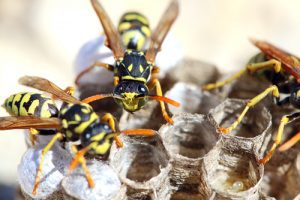Yellowjacket Nests Too Close for Comfort?
By Chris Williams on June 29, 2011.
Q. I saw some flying bees that look like yellowjackets going into a hole in the ground near our driveway. I thought yellowjackets made those big, round nests in trees?
A. You probably did see yellowjackets. First of all, yellowjackets are not “bees.” They are actually wasps, members of a related group. Bees are quite docile and very beneficial in pollinating crops and flowers. We like bees. Yellowjackets are not so docile and can be very aggressive and sting readily in certain situations. We don’t like yellowjackets so much.
Some yellowjackets (especially the black and white baldfaced hornets) do build papery nests in trees or shrubs and some yellowjackets even nest inside buildings in voids, but our most common yellowjackets are mainly ground nesters. The only sign of a yellowjacket ground nest is the entrance hole which is about the size of a nickel up to size of a quarter. Usually the yellowjackets will clear a small area around the opening.
Sometimes you may know the general area of the yellowjackets’ nests but can’t actually find the opening, especially if it is in ivy or other thick vegetation. Often, yellowjackets will re-use old rodent burrows. Or, you may see yellowjackets disappear at the base of a shrub. If you could see below ground to the nest or if you dug out a yellowjacket ground nest, you would find the same kind of nest you see in trees: an outer papery covering enclosing layers of paper combs.
Depending on the time of year, the individual cells in the combs will contain developing larvae or pupae. Yellowjacket workers collect insects to feed to the larvae. Yellowjacket nests continue to grow in size and number throughout the summer. It’s in late summer/early fall when nests are at peak size and insect prey is dwindling that yellowjackets become very aggressive in going after human food and sugary drinks.
 Yellowjackets are a problem when their nest is in an area where people may walk through it or otherwise disturb it—such as next to a porch, near a playground, or in gardens, or in yard areas that are mowed. Yellowjackets really, really don’t like it if they think their nest is being threatened! You can get fairly close to the nest as long as you don’t disturb the ground or the vegetation right around the opening.
Yellowjackets are a problem when their nest is in an area where people may walk through it or otherwise disturb it—such as next to a porch, near a playground, or in gardens, or in yard areas that are mowed. Yellowjackets really, really don’t like it if they think their nest is being threatened! You can get fairly close to the nest as long as you don’t disturb the ground or the vegetation right around the opening.
If you’re being bothered by yellowjackets around your home, getting into your hummingbird feeders or buzzing around food or drink on your deck or patio, you probably have a yellowjacket nest or nests on your property. With some practice, you can actually track yellowjackets to their nest because they all tend to leave and enter the nest on the same flight path. They’re easiest to see against the sun. Stand still and look across an area of yard that is in full sun. If you see an insect fly quickly by, continue looking in the same place. If you see more zip past in the same spot, you’ve probably found yellowjackets going to and from the nest. Follow them until you can see where they’re entering and exiting. There may be more than one opening to the same ground nest.
You can treat the nest opening with commercial wasp products. Make sure you do it after dusk when the yellowjackets are in the nest and not active. Follow label directions. Before then, place a stick or rake on the ground pointing to the nest opening so that you can find it in the dark. If all this is just a little too scary for you, call Colonial. Our trained technicians can take care of those yellowjacket nests for you so you can enjoy your yard and your summer!